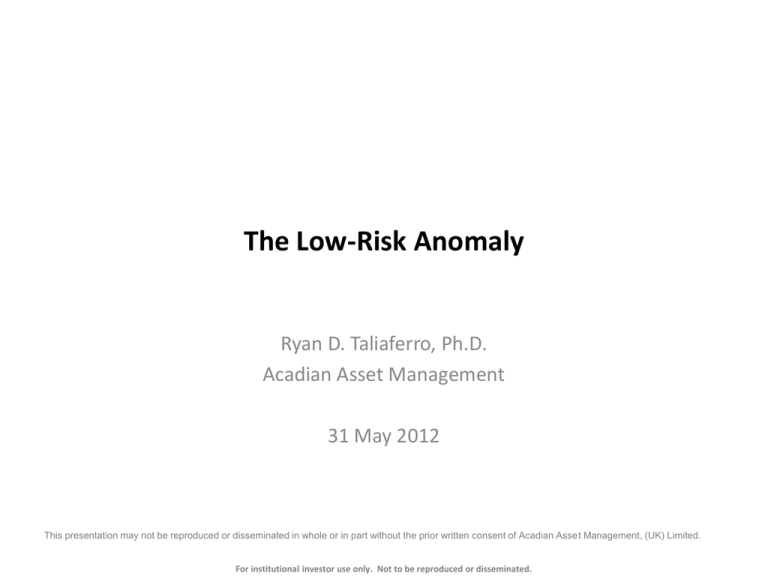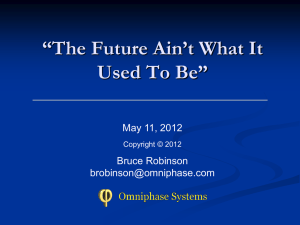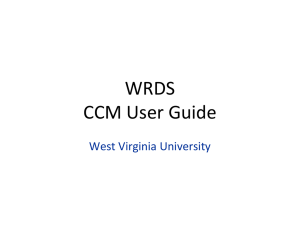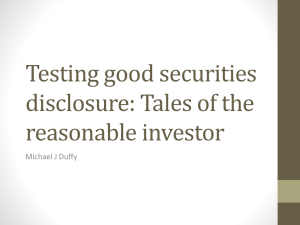
The Low-Risk Anomaly
Ryan D. Taliaferro, Ph.D.
Acadian Asset Management
31 May 2012
This presentation may not be reproduced or disseminated in whole or in part without the prior written consent of Acadian Asset Management, (UK) Limited.
For institutional investor use only. Not to be reproduced or disseminated.
What Is the Low-Risk Anomaly?
Finance theory says that investors who buy higher risk stocks will be
compensated with higher returns
Empirical reality is that risk and return are unrelated
• 80+ years in the U.S.
• Around the world
Simple conclusion: Combine lower risk stocks into a low-risk portfolio
For institutional investor use only. Not to be reproduced or disseminated.
Low-Risk Anomaly: U.S. Example
Annualized average monthly
returns, 1968-2010 (%)
10%
5%
0%
Low
2
3
Top 1,000
4
High
All Stocks
Source: Acadian Asset Management LLC, CRSP,CRSP®, Center for Research in Security Prices. Graduate School of Business, The University of Chicago. Used with permission. All rights reserved.
crsp.uchicago.edu . For illustrative purposes only. This is not intended to represent investment returns generated by an actual portfolio. They do not represent actual trading or an actual account,
but were achieved by means of using the CRSP universe of securities as a whole. Results do not reflect transaction costs, other implementation costs and do not reflect advisory fees or their
potential impact. Simulated results used to create this example are not indicative of actual future results Every investment program has the opportunity for loss as well as profit.
For institutional investor use only. Not to be reproduced or disseminated.
Low-Risk Anomaly is Everywhere
Return (%)
Benchmark
Simulated minimum variance (least risky) portfolio
10
Risk (standard deviation %)
0
-10
-20
-30
Global
EAFE
Europe
EM
US
Canada
Japan
Australia
Monthly returns 1998-2011, EM 2004-2011.
Source: Acadian Asset Management LLC, Acadian Asset Management LLC, *MSCI World, MSCI Europe, MSCI EAFE, MSCI EM, MSCI US, MSCI Canada, MSCI JP and MSCI Australia, ** EM simulation begins
January 2004. For illustrative purposes only. This is meant to be an example and is not intended to represent investment returns generated by an actual portfolio. The simulated results do not represent actual
trading or an actual account, but were achieved by means of retroactive application of a model designed with the benefit of hindsight for the period specified above. Results are gross and would be reduced by
advisory fees. Results do not reflect transaction costs, other implementation costs and do not reflect advisory fees or their potential impact. Reference to the benchmark is for comparative purposes only.
Simulated performance is not indicative of actual future results. Every investment program has the opportunity for loss as well as profit. Index Source: MSCI Copyright MSCI 2012. All Rights Reserved.
Unpublished. PROPRIETARY TO MSCI.
For institutional investor use only. Not to be reproduced or disseminated.
Why a Low-Risk Anomaly?
Behavioral explanations have two ingredients
1. Investor psychology
2. Limits to arbitrage
1. Psychology: investors are attracted to risky stocks
• Lottery preferences
• Overconfidence
• Categorization and representativeness
2. Limits to arbitrage: institutional investors are constrained
• Handcuffed to index benchmarks
• Buying a low-beta stock creates tracking-error risk
Stable effects: suggests anomaly will persist
For institutional investor use only. Not to be reproduced or disseminated.
Good News for Investors
An equity strategy that has
• Returns similar to the aggregate market, with
• Lower risk
• Lower correlation with benchmark-tied strategies
…Can be used in many ways. For example, as a potential
•
•
•
•
Risk reducer
Return enhancer
Hedge fund alternative
Equity diversifier
For institutional investor use only. Not to be reproduced or disseminated.
Good News, But We Should Dig Deeper
Risk
• Is the definition correct?
• I.e., are the stocks and portfolios identified as “low-risk” truly low-risk?
Novelty
• Could we have “rediscovered” a known pattern?
• Is the low-risk anomaly just a repackaging of an existing strategy?
For institutional investor use only. Not to be reproduced or disseminated.
Are Low-Risk Stocks Actually Low-Risk?
In extreme market downturns, stocks are more correlated
Low beta stocks
High beta stocks
U.S. 1931-2010
U.S. 1931-2010
30
30
30
Stock return (%)
Stock return (%)
Stock return (%)
20
20
20
10
10
10
0
-30
-20
-10
0
0
-10
10
20
30
Market return (%)
-30
-20
-10
0
0
-10
10
20
30
-30
Market return (%)
-20
-10
0
-10
-20
-20
-20
-30
-30
-30
10
20
30
Market return (%)
Yes, they are low-risk. Curvature is a small effect, far outweighed by slope.
Source: Acadian Asset Management LLC, CRSP,CRSP®, Center for Research in Security Prices. Graduate School of Business, The University of Chicago. Used with permission. All rights reserved.
crsp.uchicago.edu . For illustrative purposes only. This is not intended to represent investment returns generated by an actual portfolio. They do not represent actual trading or an actual account, but were
achieved by means of using the CRSP universe of securities as a whole. Results do not reflect transaction costs, other implementation costs and do not reflect advisory fees or their potential impact. Simulated
results used to create this example are not indicative of actual future results Every investment program has the opportunity for loss as well as profit.
For institutional investor use only. Not to be reproduced or disseminated.
Beta, Alpha, and Returns
U.S. 1931-2010
Beta
Alpha (monthly %)
2
10
Beta
2
1
0
0
-10
Market >5% Market Flat Market <-5%
High beta
Market excess
returns (monthly %)
Market >5% Market Flat Market <-5%
Low beta
High beta
1
Systematic excess returns
(monthly %)
Low beta
Total excess returns
(monthly %)
10
10
10
0
0
0
18%
72%
10%
0
-10
Market >5%-10
Market >5% Market Flat Market <-5%
Market Flat
Market
-10 <-5%
Market >5% Market Flat Market <-5%
High beta
Low beta
High beta
Low beta
Market >5% Market Flat Market <-5%
High beta
Low beta
Source: Acadian Asset Management LLC, CRSP,CRSP®, Center for Research in Security Prices. Graduate School of Business, The University of Chicago. Used with permission. All rights reserved.
crsp.uchicago.edu . For illustrative purposes only. This is not intended to represent investment returns generated by an actual portfolio. They do not represent actual trading or an actual account, but were
achieved by means of using the CRSP universe of securities as a whole. Results do not reflect transaction costs, other implementation costs and do not reflect advisory fees or their potential impact. Simulated
results used to create this example are not indicative of actual future results Every investment program has the opportunity for loss as well as profit.
For institutional investor use only. Not to be reproduced or disseminated.
A Rediscovery?
Most common suggestion: low-risk strategy is value (or size, etc.) in disguise
Annualized average
return, 1931-2011 (%)
20
Market
Low risk
(minimum
variance)
10
Size and value portfolios
0
0
10
20
30
Annualized standard deviation of returns (%)
But strategy holds up well in standard factor regressions (c. 250bp/year alpha)
Source: Acadian Asset Management LLC, CRSP,CRSP®, Center for Research in Security Prices. Graduate School of Business, The University of Chicago. Used with permission. All rights
reserved. crsp.uchicago.edu .For illustrative purposes only. This is not intended to represent investment returns generated by an actual portfolio. They do not represent actual trading or an
actual account, but were achieved by means of using the CRSP universe of securities as a whole. Low-risk is a hypothetical portfolio constructed using a statistical model with the benefit of
hindsight. Results do not reflect transaction costs, other implementation costs and do not reflect advisory fees or their potential impact. Simulated results used to create this example are not
indicative of actual future results Every investment program has the opportunity for loss as well as profit.
For institutional investor use only. Not to be reproduced or disseminated.
Conclusions
We believe, low risk stocks do not earn lower returns
• Instead, about the same (or higher) returns compared to riskier stocks
• Around the world, over long time periods
Surprising, but…
• Survives many tests (e.g., for novelty)
• Admits a coherent, intuitive explanation
The anomaly is likely to persist
• Investor psychology
• Benchmarking
Potentially, a promising opportunity
• Reduce risk without reducing returns
• Distinct, unrelated to other strategies: complementary to many existing strategies
For institutional investor use only. Not to be reproduced or disseminated.
Hypothetical Performance Disclosure
The hypothetical examples provided in this presentation are provided as illustrative examples only.
Hypothetical performance results have many inherent limitations, some of which are described
below. No representation is being made that any account will or is likely to achieve profits or losses
similar to those shown. In fact, there are frequently sharp differences between hypothetical
performance results and the actual performance results subsequently achieved by any particular
trading program.
One of the limitations of hypothetical performance results is that they are generally
prepared with the benefit of hindsight. In addition, hypothetical trading does not involve financial
risk, and no hypothetical trading record can completely account for the impact of financial risk in
actual trading. For example, the ability to withstand losses or to adhere to a particular trading
program in spite of trading losses are material points which can also adversely affect actual trading
results. There are numerous other factors related to the markets in general or to the
implementation of any specific trading program which cannot be fully accounted for in the
preparation of hypothetical performance results and all of which can adversely affect actual trading
results.
For institutional investor use only. Not to be reproduced or disseminated.
Legal Disclaimer
The presentation material was prepared by Acadian Asset Management (UK) Limited (“AAM-
UK”) with information it believes to be reliable and contains Acadian’s confidential and
proprietary information. The views expressed in the presentation and presentation material are
those of Acadian and are subject to change with market conditions. This presentation is for
informational purposes only and should not be construed as investment advice, or an offer to
sell or a solicitation of an offer to buy any security.
The presentation material has not been updated since it was published and may not reflect the
current views of the author(s) or recent market activity. Market conditions are subject to
change. Historical economic and performance information is not indicative of future results.
This document may not be reproduced or disseminated in whole or part without the prior
written consent of Acadian Asset Management (UK) Limited.
ACADIAN ASSET MANAGEMENT LLC
ONE POST OFFICE SQUARE
ACADIAN ASSET MANAGEMENT (UK) LIMITED
36-38 CORNHILL
ACADIAN ASSET MANAGEMENT
(SINGAPORE) PTE LTD
BOSTON, MA 02109
TELEPHONE +1-617-850-3500
LONDON, EC3V 3NG
UNITED KINGDOM
8 SHENTON WAY
#37-02
FAX +1-617-850-3501
TELEPHONE +44-20-7398-7280
FAX +44-20-7398-7281
SINGAPORE 068811
TELEPHONE +65-6508-2200
FAX +65-6508-2201
Company Registration No.: 199902125D
ACADIAN-ASSET.COM
For institutional investor use only. Not to be reproduced or disseminated.










